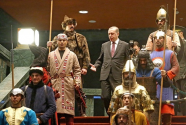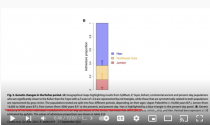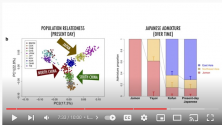A study combining linguistic, genetic and archaeological evidence has traced the origins of the family of languages including modern Japanese, Korean, Turkish and Mongolian and the people who speak them to
MILLET FARMERS who inhabited a region in Northeastern China about 9,000 years ago.
The findings detailed on Wednesday document [2021-11-10] a shared genetic ancestry for the hundreds of millions of people who speak what the researchers call Transeurasian languages across an area stretching more than 8,000 kilometers.
There are 98 Transeurasian languages. Among these are Korean and Japanese as well as: various Turkic languages including Turkish in parts of Europe, Anatolia, Central Asia and Siberia; various Mongolic languages including Mongolian in Central and Northeast Asia; and various Tungusic languages in Manchuria and Siberia.
This language family's beginnings were traced to Neolithic millet farmers in the
Liao River Valley, an area encompassing parts of the Chinese provinces of
Liaoning and Jilin and the region of Inner Mongolia. As these farmers moved across northeastern Asia, the descendant languages spread north and west
into Siberia and the steppes and east into the
Korean peninsula and over the sea to the
Japanese archipelago over thousands of years.
"Accepting that the roots of one's language, culture or people lie beyond the present national boundaries is a kind of surrender of identity, which some people are not yet prepared to make," said comparative linguist Martine Robbeets, leader of the Archaeolinguistic Research Group at the Max Planck Institute for the Science of Human History in Germany and lead author of the study published in the journal NATURE.
The researchers determined that
farmers in Northeastern China eventually supplemented millet with rice and wheat, an agricultural package that was transmitted when these populations
spread to the Korean peninsula by about 1300 BC and from there to Japan after about 1000 BC.
(...)
The linguistic relatedness of the
Transeurasian languages -- also known as ‘Altaic’ -- is among the most disputed issues in linguistic prehistory. Transeurasian denotes a large group of geographically adjacent languages stretching across Europe and northern Asia, and includes five uncontroversial linguistic families: Japonic, Koreanic, Tungusic, Mongolic, and Turkic (Fig. 1a). The question of whether these five groups descend from a single common ancestor has been the topic of a long-standing debate between supporters of inheritance and borrowing. Recent assessments show that even if many common properties between these languages are indeed due to borrowing, there is nonetheless a core of reliable evidence for the classification of Transeurasian as a valid genealogical group.
In contrast to previously proposed homelands, which range from the Altai to the Yellow River to the Greater Khingan Mountains to the Amur basin, we find support for a
Transeurasian origin in the West Liao River Region in the Early Neolithic [an area encompassing parts of the Chinese provinces of Liaoning and Jilin and the region of Inner Mongolia]. After a primary break-up of the family in the Neolithic, further dispersals took place in the Late Neolithic and Bronze Age. The ancestor of the Mongolic languages expanded northwards to the Mongolian Plateau, Proto-Turkic moved westwards over the eastern steppe and the other branches moved eastwards: Proto-Tungusic to the Amur–Ussuri–Khanka region, Proto-Koreanic to the Korean Peninsula and Proto-Japonic over Korea to the Japanese islands (Fig. 1b).
Around 3300 BP (Before Present),
farmers from the Liaodong–Shandong area migrated to the Korean peninsula, adding rice, barley and wheat to millet agriculture. This migration aligns with the genetic component modelled as Upper Xiajiadian in our Bronze Age sample from Korea and is reflected in early borrowings between Japonic and Koreanic languages. Archaeologically it can be associated with agriculture in the larger Liaodong–Shandong area without being specifically restricted to Upper Xiadiajian material culture.
By advancing new evidence from ancient DNA, our research thus confirms recent findings that
Japanese and Korean populations have West Liao River ancestry, whereas it contradicts previous claims that there is no genetic correlate of the Transeurasian language family.
(...)



